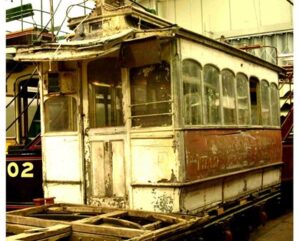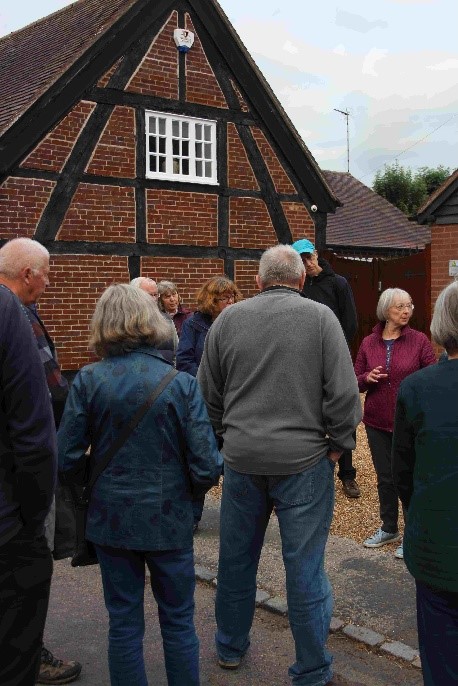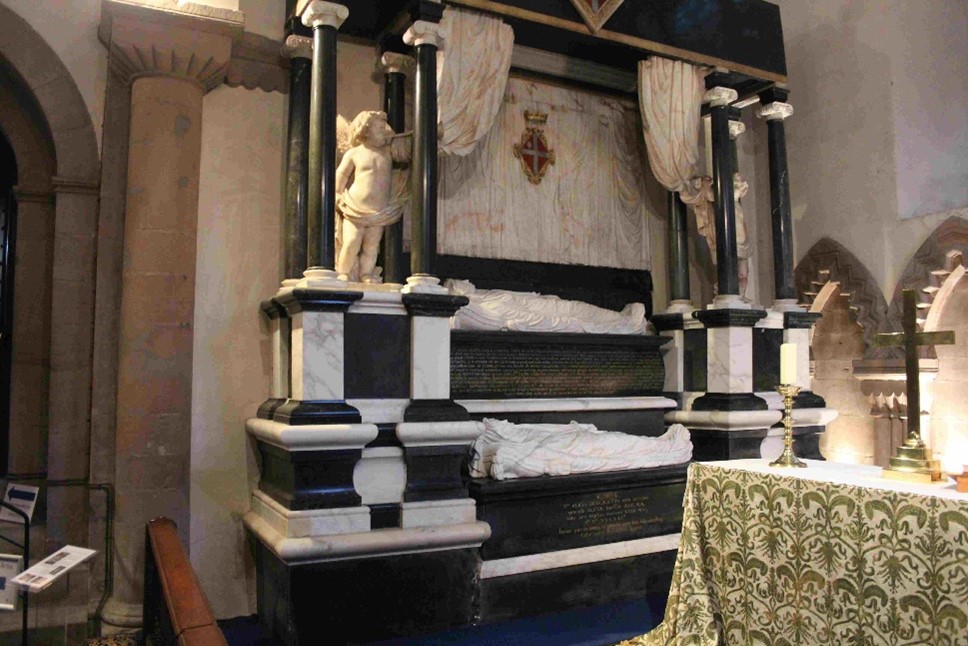Newsletter September 2021
 September Evening Talk. Our next talk in the Village Hall on Friday 17th September will be by Michael Coulls and Alan Jennings describing the Warwick and Leamington Tramways.
September Evening Talk. Our next talk in the Village Hall on Friday 17th September will be by Michael Coulls and Alan Jennings describing the Warwick and Leamington Tramways.
This operation started in 1881 running trams from outside the Lord Leycester Hospital in Warwick to Leamington Spa Station. Until 1905 the cars were horse drawn but from then until 1930 the route was electricity powered. The only surviving car is horse drawn Car no. 1, preserved in an unrestored condition in the National Tramway Museum in Crich, Derbyshire.
The original paintwork is faded but the words LEAMINGTON AND WARWICK TRAMWAY COMPANY can still be seen on the side. Some members may recollect a wonderful Group coach trip in 2007 when we also visited Arkwright’s Cromford Mill nearby.
At present there are no mandatory covid related restrictions on the use of the village hall, so we expect to present a normal evening illustrated talk.
It advised that masks should be worn, that the hand washing facilities be used, and the hall will be ventilated. If this situation changes we will immediately inform our members and friends, and set out whatever precautions or arrangements may be needed to allow the talk to go ahead.

Sheila and the group by a fine cruck cottage
Report on 2021 Summer Outings. Isobel’s hard work throughout the pandemic restrictions finally came to fruition with our first two outings since 2019: in August we were treated to an expert and informative tour round Stoneleigh by Sheila Woolf; and in early September your Chairman led a walk around the sites of the recent excavations on the fields of the Herb Centre.
First Stoneleigh. The history of the village has benefitted from Nat Alcock’s researches into its wonderful documentary and architectural evidence, illuminating the life of the community from the 16th to 18th centuries. Sheila has carried on that work with energy and commitment; for example, leading the Stoneleigh History Society not just to survey of the churchyard but also to dig out the biographies of the individuals where possible, and publishing the results on the Society’s website. This, together with her research on the Leighs of Stoneleigh Abbey, informed her descriptions of the village and its community. Stoneleigh was owned by the Leighs until the middle of the 20th century, and as well as cottages they enriched the village with many welfare buildings. The fine red sandstone almshouses where we met, endowed in 1558, housed 5 men and 5 women (count the chimneys). The Victorians built a separate one for women, one wonders what happened to elderly married couples then? The Leighs also built the school and the village club, but no pub!

The monument to Alice, Duchess of Dudley and her daughter, 1668
The village has a fine assemblage of cruck-built houses, as well as many timber-framed buildings, and we were introduced to examples of both. One had been the house of a fuller, an historic but noxious industrial activity, using urine to degrease woollen cloth, with mills driven by the nearby River Sowe. Fulling is a very ancient process – remember Vespasian taxing urine in Rome in the 1st century CE! The Leigh family monuments can be seen in the church, where charitable donations by the family and other notables are recorded in gold letters on the gallery panels. The church has a stunning chancel arch that looks so fine that it fooled me into wondering whether the Victorians had a hand in it, but no, it’s 12th century. The chancel is dominated by a formidable black and white monument, completely filling the north wall, a memorial to a mother and daughter, erected in 1668. The Leigh Chapel now houses a fine exhibition of the work of the History Society, including a “Snapshot” of village life compiled by the Stoneleigh WI in the 1980s. We have of course our own Kineton snapshot taken in 2008, in our archive. The Stoneleigh visit was a great success, thanks to Sheila, the weather, and the relief of being able to meet as a group again.

The group with David holding forth and Richard just holding
On September 8th we took an afternoon stroll around the fields at the Warmington Herb Centre on one of the hottest days for the time of year. We gathered in the shade of convenient trees and hedges to survive the heat as we viewed the sites of the recent dig. Despite the excavations being backfilled and invisible, our Chairman described the 4,000 years of history unearthed at the sites, emphasising the role of the landscape. In default of actual holes in the ground to look into, David promoted Richard Hammond to the role of honorary picture displayer. Thank you Richard, and Gill Stewart, for keeping track of the many sheets of paper. The excavations unearthed a Neolithic (2500BC) burial of a prominent man, probably under a barrow sited to be seen from a valley settlement. This was followed by a massive Iron Age bank and ditch (700BC to AD43) cut across the neck of the promontory, intended to mark a territorial boundary rather than a defendable line. Deliberately levelled and filled in before the Roman invasion of 43CE, it was replaced by a line of large posts, so it still served as some form of division into the Roman period. A twelve-sided temple was built on the east side, exactly over the Neolithic grave of 2,500 years earlier. One of the two coin hoards from the excavations was buried inside this structure. Another temple is suspected on the west; possibly the two temples served as a sort of spiritual passport control as travellers crossed from the domain of one god into that of another? A few hundred yards brought us to a site of Roman domestic occupation and other activities, with a collection of five buildings. They spanned the whole Roman period – 43 to 410CE – each replacing the one before, but each built differently as to size, shape and construction method. Their functions remain obscure, but one concealed a second early coin hoard. A large hunting dog had been buried to guard a late Roman pit, and a tiny lapdog was buried outside one of the buildings. These high-status animals, together with a pet eagle and the two coin hoards are at odds with the peasant economy evident from the domestic debris from the site. Our speculation is that the earlier “boundary” character of the area persisted into the Roman period and the function of the establishment was connected somehow with the management of this liminal zone, involving at least one wealthy individual. The picture of the Roman exploitation of the area, previously thought to be devoid of high-status sites, has recently been turned on its head by the discovery of the huge Roman villa only a few kilometres away on the Broughton Castle estate. So history is made.
Membership. If you are a Member of the group but have not paid your 2021 subscription yet (£10) our Treasurer awaits! You can pay by cheque made payable to Kineton and District Local History Group, sent or delivered, until the end of the month (see Breaking News below) to Ted Crofts, 5 Bank Close, Butlers Marston, CV35 0NL, or by BACS to our bank business account, name: Kineton and District Local History Group, sort code: 40-43-19; acc. no. 71281992. Please be sure to include your full name so we can correctly attribute your payment! Or you can pay at the talk.
2021 Programme update:
Sep 17 Peter Coulls and Alan Jennings: The Warwick and Leamington Tramways
Oct 15 Michael Luntley: From This Ground: songs and stories about 19th century Warwickshire agricultural workers
Nov 19 Ellie Reid Dressing up the Past: the 1906 Warwick Pageant and the 20th century pageant movement in Warwickshire.
Dec 10 Christmas treats
2022
Jan 21 George Derbyshire: Arts and Crafts in the Cotswolds
Feb 18 James Ranahan: The Photographer’s Gaze: Viewing Warwickshire Since 1839
Mar 18 AGM
Official covid advice and regulations may change for better or worse in the coming months, so we will be assessing the programme one meeting at a time and we will confirm each event when we are reasonably confident that we can run it.
Other Society News
Warwickshire Local History Society
K&DLHG is affiliated to WLHS and our members are entitled to join their meetings.
Many other local societies are running their talk series via zoom! Check the Warwickshire Local History Society website for up-to-date lists. https://www.warwickshirehistory.org.uk
Time Team is returning with feature on Broughton Castle Roman Villa. See link below for article:
https://www.timeteamdigital.com/news/breaking-news-time-team-is-coming-back
Warwickshire in WWII
The link below takes you to a fascinating article about WWII in the locality, keep going to the end to read about PoW Camp 31 at Ettington.
Council for British Archaeology West Midlands
CBA West Midlands have also given details of local history and archaeology podcasts.
Amongst several podcasts about the region CBAWM has recently released podcasts by Dr Roger White of the University of Birmingham on Wroxeter Roman city and the Roman West Midlands. https://historywm.com/podcasts
Other local on-line offerings:
Birmingham Museum virtual tour https://www.birminghammuseums.org.uk/bmag/virtual-tour
Herefordshire Museum and Art Gallery Life through a Lens virtual tour https://www.herefordshirelifethroughalens.org.uk/virtual-exhibitiontours/
Warwick Castle Virtual Tour https://historyview.org/library/warwick-castle/
Don’t forget to check our own website at:
Kineton and District Local History Group (kinetonhistory.co.uk)
KDLHG Committee
President: Robert Bearman MBE
Chairman David Freke
Vice-Chairman Roger Gaunt
Secretary Ilona Sekacz
Treasurer Ted Crofts
Outings Secretary Isobel Gill
Programme Secretary Claire Roberts
Other committee members
George Lokuciejewski
Catherine Petrie
Peter Waters
Rosemary Collier
Alec Hitchman
Pam Redgrave
Breaking News. Our Treasurer Ted Crofts is leaving the area for pastures new, taking effect in a few weeks. He has been an exemplary Treasurer, spreading an aura of calm, composure and efficiency. He has shown the patience of a saint in his dealings with the Kafkaesque machinations of our bank, and the even more baffling administration of PayPal, from which battles he has emerged triumphant. We will really miss him. His departure leaves us with vacancy for Treasurer; please consider whether you or a shyer fellow member might follow in his footsteps.
The committee has not met since the report in the August Newsletter.
Date of next Committee meeting: 16th September. If members wish to raise any matters for consideration by the committee please talk to one of the committee at our meetings or contact the Chairman.
DF 13.09.21
Contact: David Freke
Email frekedj@globalnet.co.uk
07876 290044